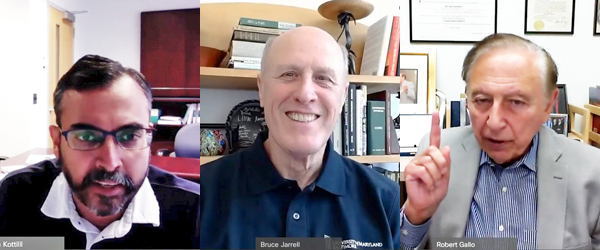June 2020
It’s an understatement, of course, to say that the worldwide mobilization of scientific resources to find a vaccine against SARS-CoV-2 — the virus that causes the disease COVID-19 — is unprecedented. As many as 160 vaccine candidates are under examination, with at least 10 already in human trials. On Wednesday, it was reported that the National Institutes of Health will fund the phase 3 trials of three of those starting this summer, the candidates of Moderna Therapeutics, Oxford University/AstraZeneca, and Johnson & Johnson.
But while the world waits for that silver bullet to end the COVID-19 pandemic, interest is surging in the scientific community for a re-examination of a decades-old vaccine for a different disease. Two esteemed scientists from the Institute of Human Virology (IHV) in the University of Maryland School of Medicine presented that case in the Journal Science on Thursday.

Drs. Shyam Kottilil, Bruce Jarrell, and Robert Gallo discuss the potential use of the Oral Polio Vaccine to provide temporary protection from COVID-19.
In the paper, Robert Gallo, MD, the Homer & Martha Gudelsky Distinguished Professor in Medicine, co-founder and director of IHV, and co-founder and international scientific advisor of the Global Virus Network (GVN), and Shyam Kottilil, MD, PhD, professor of medicine, director of IHV’s Clinical Care and Research Division and member of the GVN, suggest the oral polio vaccine (OPV), developed in the 1950s, could provide temporary protection against COVID-19 or at the very least, greatly reduce morbidity.
That vaccine uses a live virus that’s altered to reduce its virulence. The evidence, they say, indicates that live attenuated virus vaccines generally, and the OPV in particular, can induce broad protection from other pathogens, like COVID-19, by activating innate immunity mechanisms in the body.
The genesis of this renewed look at OPV is a remarkable story that came to light in discussions with another member of the GVN, Konstantin Chumakov, PhD. Now an official and microbiologist with the Food and Drug Administration, Chumakov recounted to Gallo some of the work of his parents, who were also microbiologists in the Soviet Union. Chumakov’s father organized the first large scale trials of a live virus polio vaccine developed by Dr. Albert Sabin in the 1950s. Later, in the 1970s, Chumakov’s mother published the results of research showing a surprising side effect when the OPV was administered.
“When they vaccinated against polio, there was virtually no flu,” Gallo told University of Maryland, Baltimore Interim President Bruce E. Jarrell, MD, FACS during a June 15 special edition of his regular web-based talk program, Virtual Face to Face with Dr. Bruce Jarrell. “There was an almost four-fold reduction, better than an influenza vaccine.” Part of the answer, Gallo continued, was the stimulation of interferon, which had not yet been discovered. Interferon is a protein generated by an animal’s innate immune system in response to infection, that inhibits virus replication.
Polio, influenza, and COVID-19 are all RNA viruses, Gallo continued. “We have sensors in our cells that can pick up RNA molecules that shouldn’t be there, as well as DNA molecules. Those sensors give rise to an emergency response.” That emergency response, however, does not stimulate the creation of antibodies, protective cells the body’s immune system learns to create to fight specific antigens it encounters.
“So, how long does it [protective immunity induced by the OPV] last?” Gallo asked. “We really don’t know. No one has systematically measured this. But we think … our best guess is about two months.”
“So, the idea then,” prodded Jarrell, “is that I get the polio vaccine. It produces a nonspecific response. And that innate response protects me against other RNA viruses and gets me over the hump of an epidemic.”
The clinical examination that Gallo and Kottilil propose would look at three things, Kottilil explained. “Can it prevent new infections? No. 2, if you get it after vaccination, can you get a milder version of the disease? And No. 3, if so, what’s the mechanism of action? What are the real immunological players involved in finding this out?”
Watch the entire discussion of Gallo and Kottilil’s work by accessing the link at the top of the page.
Search UMB News
Sign up for UMB Alerts.



